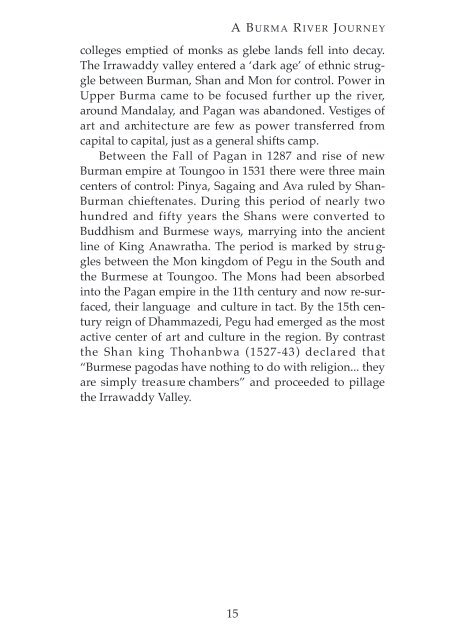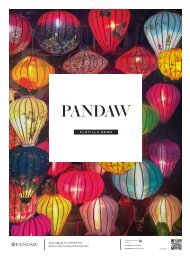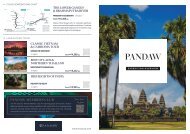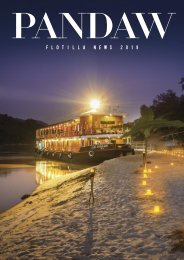Burma RJ Handbook
A handbook for travellers in Burma, by Paul Strachan.
A handbook for travellers in Burma, by Paul Strachan.
You also want an ePaper? Increase the reach of your titles
YUMPU automatically turns print PDFs into web optimized ePapers that Google loves.
A BU R M A R I V E R J O U R N E Y<br />
colleges emptied of monks as glebe lands fell into decay.<br />
The Irrawaddy valley entered a ‘dark age’ of ethnic struggle<br />
between <strong>Burma</strong>n, Shan and Mon for control. Power in<br />
Upper <strong>Burma</strong> came to be focused further up the river,<br />
around Mandalay, and Pagan was abandoned. Vestiges of<br />
art and arc h i t e c t u re are few as power transferred fro m<br />
capital to capital, just as a general shifts camp.<br />
Between the Fall of Pagan in 1287 and rise of new<br />
<strong>Burma</strong>n empire at Toungoo in 1531 there were three main<br />
centers of control: Pinya, Sagaing and Ava ruled by Shan-<br />
<strong>Burma</strong>n chieftenates. During this period of nearly two<br />
h u n d red and fifty years the Shans were converted to<br />
Buddhism and Burmese ways, marrying into the ancient<br />
line of King Anawratha. The period is marked by stru g-<br />
gles between the Mon kingdom of Pegu in the South and<br />
the Burmese at Toungoo. The Mons had been absorbed<br />
into the Pagan empire in the 11th century and now re-surfaced,<br />
their language and culture in tact. By the 15th century<br />
reign of Dhammazedi, Pegu had emerged as the most<br />
active center of art and culture in the region. By contrast<br />
the Shan king Thohanbwa (1527-43) declared that<br />
“Burmese pagodas have nothing to do with religion... they<br />
a re simply tre a s u re chambers” and proceeded to pillage<br />
the Irrawaddy Valley.<br />
15












